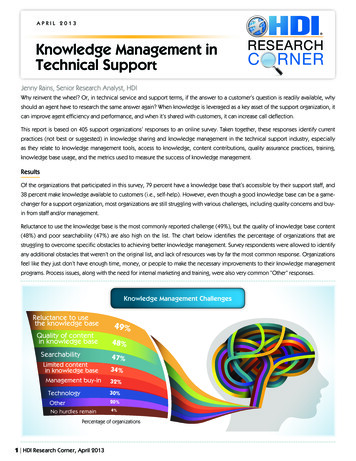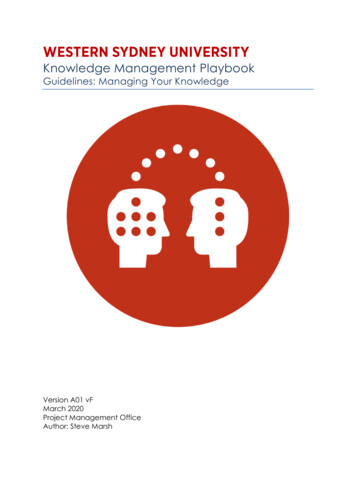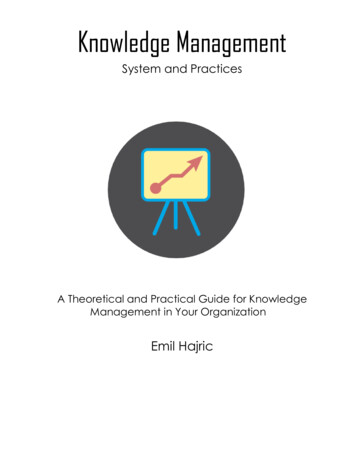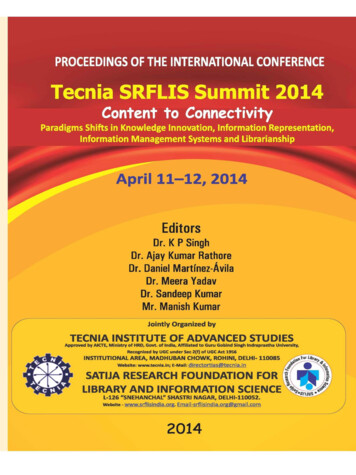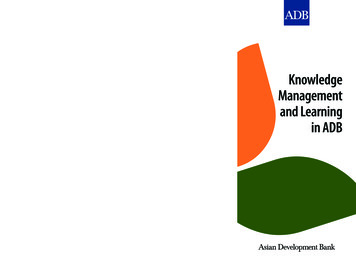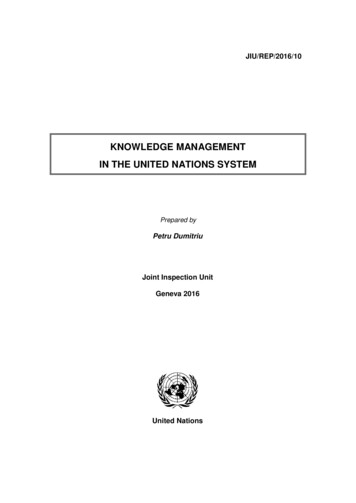
Transcription
Integrated Knowledge Managementin the Field of Big Data Foresightand Associated Digital PlatformsWP2 Report8 April 2019Jari Kaivo-oja, Steffen Roth, Arūnas Augustinaitis,Mikkel Stein Knudsen, Mathew Maavak, Levan Bzhalava, Darius Verbyla,Austė Kiškienė and Theresa Lauraeuswww.ksu.lt
Report was developed under Project „Platforms of Big Data Foresight (PLATBIDAFO)“.Project is implemented under funding of European Regional Development Fund.Ataskaita parengta vykdant projektą ,,Didžiųjų duomenų platformos ateities įžvalgoms“, finansuojamas pagalpriemonės Nr. 01.2.2-LMT-K-718 „Tiksliniai moksliniai tyrimai sumanios specializacijos srityje“ veiklą„Mokslininkų iš užsienio pritraukimas vykdyti mokslinius tyrimus“.Nr. 01.2.2-LMT-K-718-02-0019Projektas finansuojamas Europos Regioninės plėtros fondo lėšomisThe authors’ language is uncorrectedPublished by Kazimieras Simonavičius UniversityDariaus ir Girėno st. LT-02189 Vilnius, LithuaniaE-mail: info@ksu.ltwww.ksu.ltFree publicationISBN 978-609-95634-9-7 Jari Kaivo-oja, Steffen Roth, Arūnas Augustinaitis,Mikkel Stein Knudsen, Mathew Maavak, Levan Bzhalava,Darius Verbyla, Austė Kiškienė and Theresa Lauraeus, 2019 Kazimieras Simonavičius University, 2019
Contents1. Introduction42. Big Data library development73. Open innovation tools and crowdsourcing with Big Data174. Knowledge management aspects of foresight analyses with Big Data235. E-commerce tools and algorithms with Big Data and foresight processes276. Platform economy and platform approach307.Integration challenges in Big Data field: Ethical codes and other integration challenges 327.1. Ethical aspects327.1.1. Issues of ownership and transparency327.1.2. Data ecology issues: misinformation, overload, pollution337.2. Further big data integration challenges348. Methodological and theoretical challenges in the big data field36References39Annex 1: „Platforms for Big Data Foresight“ Project Activities (Nov. 2018 – Mar. 2019)46Annex 2: „Platforms for Big Data Foresight“ Project Publications (Nov. 2018-)347
1. IntroductionOxford Dictionaries define Big Data as: “Extremely large data sets that may be analyzedcomputationally to reveal patterns, trends, and associations, especially relating to human behaviorand interactions: much IT investment is going towards managing and maintaining Big Data” (OxfordDictionaries, 2019).This survey report focuses on knowledge management aspects of Big Data analytics andapplications. Big data analytics is a special field that concerns how to (1) analyze, (2) systematicallyextract information from many data sources, or (3) otherwise deal with data sets that are too largeor complex to be dealt with by traditional data-processing application software.Big Data with many cases or data rows offer greater statistical power, while Big Data with highercomplexity with more attributes or columns may lead to a higher false discovery rate because ofproblems of data management. Today typical Big Data key challenges include: (1) Capturing data,(2) creating data storage, (3) performing data analysis, (4) performing data search, (5) sharing data,(6) transferring data, (7) data visualization, (8) querying data, (9) updating data files, (10) data andinformation privacy and (11) data source(s).Gartner defines big data as “high-volume, velocity and/or variety information assets that demandcost-effective, innovative forms of information processing that enable enhanced insight, decisionmaking and process automation.” (LeHong and Laney, 2013). This needs to be augmented byaspects such as veracity (how much noise and uncertainty is in the big data) and value (value of bigdata) amongst others (Moorthy et al, 2015) as outlined in Fig. 1.Figure 1. Big Data – conventional 5 Vs.Before Big Data key concept of knowledge management was Business intelligence, which wasdominating many discussions in the field of knowledge management. In Fig. 2 we can see howpeoples interest in business intelligence has been developing in 2004-2019 (before 14.3.2019),when we analyze the big data base of Google Trends.4
17-102018-032018-082019-010-40Business Intelligence Index (0-100)Big Data Index (0-100)Linear (Business Intelligence Index (0-100))Linear (Big Data Index (0-100))Figure 2. Business Intelligence Index and Big Data Index Trends in 2004-2019 with Linear Trend Lines (Index 0-100).Source: Google Trends (2019) Monthly Global Data from Google Trends 24.3.2019.https://trends.google.fi/trends/?geo FI).Liang and Liu (2018) have analyzed research landscape of Business Intelligence and Big Dataanalytics. They note that in the last five years, the trend of “Big Data” has emerged and become acore element of Business Intelligence research. Key high frequency words in this field are:“datamining”, “social media, “information system”. After 2016, new high frequency keywords havebeen “cloud computing”, “data warehouse” and “knowledge management”.We can conclude that interest in Big Data analytics has development much especially after 2012,while interest in business intelligence has decreased in the long-run. Big Data analytics will haveimpacts on many fields of life. People are more and more interested about Big Data andopportunities which it will provide. Big Data is a revolutionary phenomenon, which is one of themost frequently, occurred topics in scientific and practical discussions nowadays. In Fig. 3 we havereported forecast about big data market worldwide in 2011-2027 in billion U.S. dollars.5
Forecast revenue big data market worldwide 2011-2027: Market volume inbillion U.S. dollarsBillion US dollars120,100,80,60,40,20,0,YearFigure 3. Big data market size revenue forecast worldwide from 2011 to 2027.: Market volume in billion U.S. dollars,Data source: Wikibon; Silicon ANGLE, Survey period March 2018.We can expect that in the global economy and business the importance of knowhow in the field ofBig Data analytics is growing. Many business organizations and corporations invest in Big Datacompetences and dynamic capabilities (see e.g. Eckroth, 2018). Key functions in organizations are(1) Big Data storage, (2) Big Data processing, (3) Big Data nalyzing and (4) Big Data transmissions.Current survey paper indicates that key issues in Big Data research are (1) descriptive analyses, (2)predictive analyses and (3) classification issues of Big Data (Shadroo and Rahmani, 2018, p. 27).6
2. Big Data library developmentLibraries have a long time been important social institutions that help people access variousinformation resources. With the continuous development of information technologies (ITs), librarieshave been evolving constantly, and this has greatly expanded library services and improved theirefficiency and effectiveness.The Online Computer literacy Centre (OCLC) was originally conceived in 1967 as the Ohio CollegeLibrary Center to integrate varied and dispersed library resources into a single electronic database.Today WorldCat, formed by libraries around the world, has over 300 million records of physical andelectronic books and journals, recordings, movies, maps and assorted data. However, these 300million individual records still remain largely isolated in the Web, requiring integration for ease ofaccess and analysis (Teets and Goldner, 2013).The concept of a global digital library gathered further impetus after the introduction of the WorldWide Web in the early 1990s.After years of practical application and development, digital libraries have gradually become a veryimportant aspect in the development of modern libraries. Digitalization of data and informationsystems is a trend in developed economies. Instead of analog storages, more and more digitalstorages can been developed in modern societies. We can note that mankind is on a quest to digitizethe world. Especially, the concept of Digital Twin will an important part of digitalization of economicand human activity. Industry 4.0 approach is based on digitalization (see Kaivo-oja, Kuusi, Knudsen& Lauraeus, 2019 and Knudsen, Kaivo-oja & Lauraeus, 2019).Nowadays data sets grow rapidly- in part because they are increasingly gathered by cheap andnumerous information- sensing Internet of Things devices such as (1) mobile devices, (2) aerial(remote sensing), (3) software logs, (4) cameras, (5) microphones, (6) radio-frequency identification(RFID) readers and (7) wireless sensor networks (Hellerstein 2008, Segaran & Hammarbacher, 2009).Today these machines generate data a lot faster than people can do it, and their production rateswill grow exponentially with Moore’s Law. Storing this big data is cheap, and it can be mined forvaluable information. The world's technological per-capita capacity to store information has roughlydoubled every 40 months since the 1980s (Hilbert & López 2011) as of 2012, every day 2.5 exabytes(2.5 1018) of data are generated. (IBM, 2013).Based on an IDC report prediction, the global data volume will grow exponentially from 4.4zettabytes to 44 zettabytes between 2013 and 2020 (Hajirahimova & Aliyeva, 2017). By 2025, IDCpredicts there will be 163 zettabytes of data (Reinsel, Gantz and Rydning, 2017).Today demand for Big Data is growing in the digital library field (De Mauro, Greco, & Grimaldi, 2016).It is surprising that relatively few studies have investigated digital libraries relative to Big Data. Oneobvious reason for the lack of such studies is that many people still think that traditional databasemanagement systems can handle the daily data storage and business processing requirements ofdigital libraries (see Xu, Du, Wang, & Liu, 2017).7
An “upper ontology” or knowledge graph approach has been advocated for the organization of dataof such variety, volume and complexity. A knowledge graph is a model of relationships betweenentities or objects in a given space. As libraries are entrusted with organizing knowledge, the entitiesin a library knowledge graph must be quite broad and should include the following key entities(Teets & Goldner, 2013, pp. 432):People: Traditionally involved people with formally published works. Increasingly, however, wemust account for individuals involved in activities ranging from writing, reviewing, publishing tosimply using library content.Items: Physical items held within libraries (e.g. books and media) and electronic-only informationsuch as e-books, journal articles and digital scans of real objectsPlaces: Geographic locations past and present must be maintained to understand contextofpublished works.Events: Events can account for grand events such as a public performance by a rock music group,and also minor events such as a user viewing a book text;Organizations: Organization entities encompass corporate names, publishers, political parties andbodies, and associations;Concepts: Subject classification systems such as the Dewey Decimal Classification system andLibrary of Congress Class system are well-known concept organization schemes. More sophisticateddata-linking systems are being developed.In a nutshell, the reorganization of library databases and functions necessitate the adoption of BigData Analytics (BDA) and associated restructuring tools. It has wider applications as well in the opensource realm: Big data can be used to automatically discover relationships in innovation activities.An integrated system should be able to recognize and enable communications betweengeographically-dispersed researchers working on a similar subject. As Teets and Goldner (2013)observed: “Just making big data sets accessible is not a desired end point. It is about making thedata reusable in combination with other data sets across the Web.” For example, text mining of BigData can be applied in many ways in innovation and foresight studies (see Bzhalava et al. 2019a,2019b and 2019 c).Some scholars like Chen et al. (2014) think that changes in five specific aspects are particularlyobvious: (1) changes in the international data environment require digital libraries to manage BigData; (2) changes to scientific research methods require digital libraries to support more data-drivenresearch environments; (3) the transfer of the innovation model requires digital libraries to meetthe needs of business development; (4) changes in user information literacy require digital librariesto meet the needs of knowledge search; and finally (5) digital libraries must adapt to developmentand changes in information technology to upgrade old service platforms to newer. In Fig. 4 we canpresent methods and trends of digital library transformation in the Big Data era.8
Figure 4. Methods and trends of digital library transformation in the Big Data era. (Li, Jiao, Zahng, & Xu, 2019, p. 28)Big Data sources in the Internet of Things and trend development of Internet connected devices isvisualized in Fig. 5. We can conclude that the business relevance of Big Data management isincreasing in the future.Figure 5. Big Data sources in the Internet of Things and number of Internet-connected devices(Ahmed et al., 2017).In Fig. 6 we can visualize Big Data flow (1) from IoT Infrastructure to Big Data Platform and (2) finallyto Big Data Analytics (Ahmed et al., 2017, Ge et al., 2018). Key processes from the IoT Infrastructureto the Big Data Platform are: CaptureIntegrateStore andPreprocess.9
Figure 6. Big Data Flow (Ahmed et al., 2017)Key processes from the Big Data Platform to the Big Data Analytics are: Mapping Transformation and Cleaning.Key elements of Big Data Analytics are: Exploring Cleaning Analyzing and Sharing.In Fig. 7 we have presented the key characters of Big Data with the fundamental idea that Big Datawith various characters will leads to high quality foresight analytics.In recent study about critical factors influencing effective use of big data, the following thematicorganizational issues were identified to be important (Surbakti et al., 2019, p. 6):1. Organizational cultural competence,2. Talent management,3. Change management program,4. Strategic alignment,5. Project management,6. Performance management,7. Organizational structure and size,8. Interdepartmental collaboration,9. Communication,10. Top management support,11. Environmental effect,12. Clear goals, and13. Focus on innovation.10
In the study about critical factors influencing effective use of big data, the following thematicsystems, tools and technologies issues were identified to be important (Surbakti et al., 2019, p. 7):1. System quality,2. IT Infrastructure, and3. Vendor support.In the study about critical factors influencing effective use of big data, the following thematic peopleaspects were identified to be important (Surbakti et al., 2019, p. 7):1.2.3.4.5.6.People’s knowledge and skills,Trust,Champions,Employee engagement,User participation, andIndividual characteristics.In the planning and management processes of Big Data libraries and services these thematic issuesare highly relevant. Naturally, factors of data and information quality are always important. Otherrelevant aspects are data completeness, data currency, data access, data relevance, data accuracyand data consistency (Surbakti et al., 2019, p. 9).Figure 7. The Characters of Big Data (modification of Mahdavinejad et al., 2018).11
In Fig. 7 the FAROUT refers to Future-orientation, Accuracy, Resource use, Objectivity, Usefulnessand Timelines, 6 key quality criteria of futures and foresight studies (see Kaivo-oja and Roth, 2019).Big Data Library research and development is a challenging issue. It is very clear that library containsbig data which are valuable but wait for exploration. Big data research and development is differentand relatively new field. In status and directions study Xu et al. (Xu et al., 2017) identified thefollowing challenges:1.2.3.4.5.6.Lack of data scientists,Ability of adopting Big Data is low,Budget issues,Technical challenges,Privacy challenges, andBig Data is not for all organizations.In order to solve all these challenges listed above, there is need to develop Big Data technology andeducate new generation of Big Data scientists and specialists. There is often non-linear dynamics inBig Data R&D activities. Change of mind set is often needed, because old habits and models lead usconventional solutions, which do not help us to solve these challenges. However, a lot of librariesbegin to embrace big data technology and many interesting pilot projects are going on. Such issueslike (1) the needs of data-driven decision-making, (2) new data formats, (3) data standards and datamodelling, (4) library data visualization, (5) user behavior studies and (6) big data technologypossibilities are key issue in Big Data library projects (Xu et al., 2017, p. 84-85). Especially theperspective of personalized user services is critical issue and needs special attention (Li et al. 2019).In Fig 8 the Big Data lifecycle is visualized. Big Data lifecycle starts from (1) Study and planning phaseleading to (2) Data collection, (3) Data documentation and quality assurance, (4) Data integration,(5) Data preparation, (6) Data analysis, (7) Publishing and sharing and finally to (8) Data storage andmaintenance and (9) Data reuse.When a Big Data platform owner has implemented the Big Data lifecycle once, it is easier to makenew data cycle rounds and new elements to Big Data analytics.12
Figure 8. The Big Data Lifecycle (Blazquez and Domenech, 2018)In Fig 9 we have presented a comprehensive classification of key sources of socio-economic BigData.Figure 9. Classification of sources of socio-economic Big Data (modification of Blazquez and Domenech, 2018).13
In Table 1 we present different data sources, short description of data sources and functions of usersTable 1. Data sources, short descriptions of data sources and functions of users. (modification of Blazquez and Domenech, 2018).In Table 2 we present some examples of Big Data sources.Table 2. Examples of Big Data sources14
In Fig. 10, genesis of Big Data applications is visualized. Genesis of Big Data applications is includingthe gradual development of the architecture of candidate applications from early desktop to recentversions (Abolfazli et al., 2014).Figure 10. Genesis of big data applications, including the gradual development of the architecture of candidateapplications from early desktop to recent versions (Abolfazli et al., 2014).In Fig. 11, Big Data architecture for nowcasting and forecasting social and economic changes isvisualized (see Blazquez & Domenech 2018).15
Figure 11. Big Data Architecture for Nowcasting and Forecasting Social and Economic Changes (Blazquez & Domenech,2018).Fig. 11 informs us that in Big Data analysis, we must pay attention to (1) data receiving module, (2)data preprocessing module, (3) data integration module, (4) data preparation module, (5) dataanalytics module and finally to (6) results publishing module. The right combination of Big Datatechnologies must be selected in order to reach scalable services, better performance and accuracy.The question of horizontal and vertical scaling is a critical issue in the selection of Big Data analyticsplatforms. Each approach has advantages and disadvantages. Human-to-human, human-tomachine and machine-to-machine interactions need always special attention. Smart cityapplications must be tailored to local conditions (see e.g. Oussos et al., 2018, p. 431, Osman 2019,Kaivo-oja et al. 2019).We can conclude that there are many activities in the field Big Data analytics. Next, we shall discussmore about innovation management and Big Data challenges.16
3. Open innovation tools and crowdsourcingwith Big DataThere are various Big Data Analysis techniques: Data miningWeb miningVisualization methodsMachine learning toolsOptimization methodsSocial network analysis andMixed Method Approach.Fig. 12, we present basic dimensions of data analytics and quantitative and qualitative research.Our message is here that there is no reason to have “black-and-white” thinking concerning Big andSmall Data or quantitative and qualitative data analyses. Both approaches can provide newinsights to other “side of coin”. Methodological pluralism is needed to boost better foresight andinnovation analyses.Figure 12. Big Data, Small Data, Qualitative Research and Qualitative Research.As in modern days technological change is intensive and product life cycles are considerablyshortened, companies engage in open innovation to cope with the increased risks and costs of R&Dprojects and to acquire the needed resources from external actors (Chesbrough, 2017, Bzhalava andCantner, 2018) Moreover, firms combine foresight practice with innovation activities to scanexternal environment, detect technological opportunities and develop groundbreaking innovations(Kaivo-oja, 2012; Kaivo-oja et al., 2015) but many companies face problems to process massiveamounts of external information, anticipating signals of impending technological changes andadjusting their innovation activities accordingly. As human decision makers have limited knowledgeand attention span as well as show cognitive and motivational biases, they often make errors in17
decision making (Goodwin and Wright, 2004, De Dreu, at al., 2008, Ocasio, 2011, van Knippenberget al., 2015, Piezunka and Dahlander 2015). Moreover, many incumbent firms face problems toanticipate disruptive technology changes because they often originate outside companies’ area ofexpertise (Day and Schoemaker, 2004; Heuschneider and Hersta, 2016). To deal with these issues,organizations increasingly seek to employ automated foresight and innovation management tools.Previous studies develop text mining methods to analyze large volumes of literature and patent dataas well as web news to automatically identify meaningful patterns and trends in technologicaldevelopment, to strengthen peripheral vision and, as a result, to advance strategic planning inorganizations (Yoon, 2012; Thorleuchter and Van den Poel, 2013; Thorleuchter at al., 2014; Choi etal., 2012, Guo et al., 2016, Kim et al., 2016). These methods include text segmentation, termassociation, cluster generation, topic identification, and information mapping for derivingtechnology intelligence from scientific articles and patent data (Tseng et al., 2007). Moreover, toautomate weak signal detection tools, the keyword-based text mining approach (e.g. keywordcluster map, keyword intensity map and keyword relationship map) is proposed (Yoon, 2012, Kimet al., 2016). The keyword cluster map approach identifies future-related homogeneous topics byclassifying frequently co-occur keywords into clusters. Keyword intensity map assesses strength ofthe keywords for each topic by measuring keyword frequency (visibility) and the degree of diffusionbased on document frequency (Yoon, 2012; Kim et al., 2016). Based on this, short-term, mediumterm and long-term signals are classified, and keyword relationship map is built to categorizekeywords into technology roadmaps. Furthermore, Thorleuchter and Van den Poel (2013) employ alatent semantic indexing text mining method, which considers the aspects of meaning and identifiessimilar textual patterns in different contexts, to recognize weak signals in the internet-basedenvironment and to support strategic decision making.As in modern days technological change is intensive and product life cycles are considerablyshortened, firms have increased the degree of their openness in innovation to source knowledgefrom a wide set of external actors and, in this way, to develop innovation relatively quickly andinexpensively (Chesbrough, 2017). However, given that firms’ absorptive capacity or knowledgebase is limited, they face challenges to identify and utilize knowledge from new and unfamiliartechnological areas (Laursen and Salter, 2006; Monteiro et al., 2017). This, in turn, negatively affectsa firm’s innovation performance. To cope with this issue, previous research proposes text miningtools to automatically select external partners for a given problem. In particular, Subject-ActionObject semantic analysis is developed to identify technological trajectory and opportunity as wellas to search solutions in patent or internet-based environment by organizing text in a problem–solution format where the action–object (AO) states the problem and the subject (S) forms thesolution (Choi et al., 2012, Guo et al., 2016).Moreover, to improve market intelligence, the topic modeling method of text mining is used tocalculate business proximity between firms for potential merging and acquisition. In particularly, Shiat al. (2016) analyze publicly available business descriptions of startups to identify potentialsuccessful matches between firms based on similarity of their business topic distribution. Textmining methods are also proposed for developing automated tools for smart specialization strategymanagement and analysis. In particularly, Bzhalava et al. (2018), use topic modeling method of textmining to identify key economic areas in which entrepreneurs from different EU regions see newbusiness opportunities and in which areas they identify possibilities of smart specialization. Thestudy shows that text mining can be used to identify dominant topics and trends in startup18
entrepreneurial activities across regions and to develop automated management tools and planningapproaches for Smart Specialization Strategy.All these new analytical tools can be used in crowdsourcing process where a lot of crowdsourceddata is available. Today crowdsourcing challenges are fast emerging as an effective tool for solvingcomplex innovation problems. Howe (Howe, 2006, 2008, 2009) has classified the applications ofcrowdsourcing into the following four categories:(1) Collective intelligence (or wisdom of the crowd). People (in a crowd) solving problems andproviding new insights and ideas leading to product, process, or service innovations (e.g., see [18]).(2) Crowd creation (or user-generated content). People creating various types of content andsharing it with others for free or for a small fee.(3) Crowd voting. People giving their opinion and ratings on ideas, products, or services, as well asparsing, evaluating, and filtering information presented to them.(4) Crowdfunding. This is a special model in which people can raise money for investment,donations, or for micro-lending of funds.It is important to understand that there are many alternative crowdsourcing techniques. In Fig. 13we have outline four alternatives: (1) Crowd-voting, (2) idea crowdsourcing, (3) micro-taskcrowdsourcing and (4) solution crowdsourcing.Figure 13. Crowdsourcing alternatives (Prpic et al., 2015, p. 79).Crowd-voting means that an organization requests choices between alternatives and thenaggregates the votes. Idea crowdsourcing means that an organization invites opinions for small orbig questions and then evaluates the proposed ideas. Micro-task crowdsourcing means that anorganization breaks problems into smaller jobs and then re-assembles the completed tasks. Solutioncrowdsourcing means that an organization invites and tests contributions for very specific problemsand then adopts the best non-falsifiable solutions. (see Prpic et al., 2015).When applying Crowdsourcing Delphi methodology (see Santonen and Kaivo-oja, 2019) we canmake a choice concerning these four alternatives on the basis of (1) type of contribution (objective19
or subjective) and (2) content (aggregate or filtered). Traditionally, the term ‘crowd’ has been usedalmost exclusively in the social context of people who are self-organized around a common purpose,idea, invention, innovation, emotion, or experience. Today firms and public agencies often refer tocrowds in discussions of how collections of individuals can be engaged for organizational purposes.Crowdsourcing means the use of information technologies to outsource business or other thinkingresponsibilities to crowds. Crowdsourcing can significantly influence an organization s ability toleverage previously unattainable resources to build competitive advantage and novel products andservices (Prpic et al., 2015). Furthermore Ross Dawson (2010) identified the followingcrowdsourcing platforms, which are in Table 3 aligned to Prpic et al. 2015 crowdsourcingalternatives a.k.a. types.Table 3. Crowdsourcing platforms and types (Santonen and Kaivo-oja, 2019)Platform typeDescriptionCS typeDistributedinnovationplatformsSupport innovation processes that cross organisational boundaries Solutionor take place entirely outside an organisation. Some notable CSresources include Innovation Exchange, which allows agencies andorganisations to present innovation challenges to a community ofinnovators.Idea platforms Are used within a company context to be able to gather and filter Idea CSand source ideas that are proposed. Often managers or workerssubmit ideas or proposals for cost savings, or new products, or newservices, or process efficiencies, and then they collectively assessand rate and vote on and select and evolve and refine and build onthose ideas to become the innovation that will drive thatorganisation forward.InnovationprizesandCompetitionplatformAre challenges designed to catalyse new thinking and ingenuity. Idea CSTypically, anybody anywhere can enter their own projects and ideas, Ideaand others can vote on them and build on them and use the wisdom votingof the crowd to make them more effective, and from all of thosesubmissions somebody wins a big sum of money.ContentmarketsAre platforms where people submit their content for people to Ideapurchase. A typical example is Threadless, which allows people to votingsubmit designs for t-shirts, with the community voting for the bestone
4. Knowledge management aspects of foresight analyses with Big Data 23 5. E-commerce tools and algorithms with Big Data and foresight processes 27 6. Platform economy and platform approach 30 7.Integration challenges in Big Data field: Ethical codes and other integration challenges 32 7.1. Ethical aspects 32 7.1.1.




